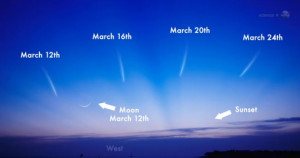 If you have ever wanted to get a live view of a comet in the night sky, this month of March could your chance. Astronomers have already confirmed sighting comet C/2011 L4, also known as comet PanSTARRS in the night sky in the southern hemisphere. (watch a video of the comet sighting here) As for the rest of us in the northern hemisphere, our opportunity to see comet Pan-STARRS in the sky is almost here.
If you have ever wanted to get a live view of a comet in the night sky, this month of March could your chance. Astronomers have already confirmed sighting comet C/2011 L4, also known as comet PanSTARRS in the night sky in the southern hemisphere. (watch a video of the comet sighting here) As for the rest of us in the northern hemisphere, our opportunity to see comet Pan-STARRS in the sky is almost here.
While the best opportunity to see comet PanSTARRS will be from March 12th to March 24th 2013, you may be able to get a glimpse of it by the end of the week. The information video below on comet Pan-STARRS from NASA will provide more information on where to look and what to expect.
PanSTARRS, like other comets is believed to come from an area near the outer reaches of our solar system, known as the Ort cloud. In this area are millions of chunks of rock and ice left over from the formation of the solar system. Periodically one of these falls out of its orbit and heads for a pass near the sun.
As the ice heats up approaching the sun, the melting ice creates what is commonly referred to as the comet’s tail. This pass by comet Pan STARRS is its first according to astronomers. It is a new comet, and exactly how bright it will be is not certain, however most expect it to be very visible in the western sky just after sunset.
Where to look to see comet PanSTARRS?
While a telescope or binoculars will give you a better view, experts expect that Pan STARRS will be visible to the naked eye. To see the comet, look to the west just after sunset. Comet PanSTARRS should be visible just to the left and slightly higher than the Moon. As the month continues, the comet will appear more and more to the right of that position each evening.
This information video about comet Pan-STARRS explains more about the comet and what viewers can expect to see in the sky. NASA has cautioned that “Comet Pan-STARRS should not be confused with another, even better comet coming later this year. In Nov. 2013, Comet ISON could shine as brightly as a full Moon in broad daylight when it passes through the atmosphere of the sun.”
![Herbal Reference Substances are Key to Everyday Products <!-- AddThis Sharing Buttons above -->
<div class="addthis_toolbox addthis_default_style " addthis:url='http://newstaar.com/herbal-reference-substances-are-key-to-everyday-products/3512112/' >
<a class="addthis_button_facebook_like" fb:like:layout="button_count"></a>
<a class="addthis_button_tweet"></a>
<a class="addthis_button_pinterest_pinit"></a>
<a class="addthis_counter addthis_pill_style"></a>
</div>When it comes to quality control testing and the development of new products, Botanical Reference Materials (BRMs), also known as Herbal References are critically important. To help companies ultimately obtain all-important FDA approval, the Food and Drug Administration provides in its guidance a recommendation that […]<!-- AddThis Sharing Buttons below -->
<div class="addthis_toolbox addthis_default_style addthis_32x32_style" addthis:url='http://newstaar.com/herbal-reference-substances-are-key-to-everyday-products/3512112/' >
<a class="addthis_button_preferred_1"></a>
<a class="addthis_button_preferred_2"></a>
<a class="addthis_button_preferred_3"></a>
<a class="addthis_button_preferred_4"></a>
<a class="addthis_button_compact"></a>
<a class="addthis_counter addthis_bubble_style"></a>
</div>](http://newstaar.com/wp-content/uploads/2021/02/Achillea_millefolium_flowers-100x100.jpg)
![Quality Electrochemical Biosensors are Critical for Medical, Food and Chemical Industry <!-- AddThis Sharing Buttons above -->
<div class="addthis_toolbox addthis_default_style " addthis:url='http://newstaar.com/quality-electrochemical-biosensors-are-critical-for-medical-food-and-chemical-industry/3512086/' >
<a class="addthis_button_facebook_like" fb:like:layout="button_count"></a>
<a class="addthis_button_tweet"></a>
<a class="addthis_button_pinterest_pinit"></a>
<a class="addthis_counter addthis_pill_style"></a>
</div>A number of industries have, at their core, a need to frequent or even continuous analysis of biological media. These include the medical and pharmaceutical fields, biotech firms, and food and chemical companies. To maintain quality standards and develop new products, these industries rely heavily […]<!-- AddThis Sharing Buttons below -->
<div class="addthis_toolbox addthis_default_style addthis_32x32_style" addthis:url='http://newstaar.com/quality-electrochemical-biosensors-are-critical-for-medical-food-and-chemical-industry/3512086/' >
<a class="addthis_button_preferred_1"></a>
<a class="addthis_button_preferred_2"></a>
<a class="addthis_button_preferred_3"></a>
<a class="addthis_button_preferred_4"></a>
<a class="addthis_button_compact"></a>
<a class="addthis_counter addthis_bubble_style"></a>
</div>](http://newstaar.com/wp-content/uploads/2020/10/Electrochemical-Biosensor-100x100.jpg)
![Company Develops Industrial Mixers Well-Suited for both Fragile and Explosive Products <!-- AddThis Sharing Buttons above -->
<div class="addthis_toolbox addthis_default_style " addthis:url='http://newstaar.com/company-develops-industrial-mixers-well-suited-for-both-fragile-and-explosive-products/3512071/' >
<a class="addthis_button_facebook_like" fb:like:layout="button_count"></a>
<a class="addthis_button_tweet"></a>
<a class="addthis_button_pinterest_pinit"></a>
<a class="addthis_counter addthis_pill_style"></a>
</div>Industrial drum mixers are normally applied to blend mixes of varying viscosities such as adhesive slurries or cement. Some of these mixers have the capability of blending mixes of very different particle sizes such as fruit and ice cream, and gravel and cement slurry. The […]<!-- AddThis Sharing Buttons below -->
<div class="addthis_toolbox addthis_default_style addthis_32x32_style" addthis:url='http://newstaar.com/company-develops-industrial-mixers-well-suited-for-both-fragile-and-explosive-products/3512071/' >
<a class="addthis_button_preferred_1"></a>
<a class="addthis_button_preferred_2"></a>
<a class="addthis_button_preferred_3"></a>
<a class="addthis_button_preferred_4"></a>
<a class="addthis_button_compact"></a>
<a class="addthis_counter addthis_bubble_style"></a>
</div>](http://newstaar.com/wp-content/uploads/2020/06/bandeau-sofragir2-100x100.jpg)